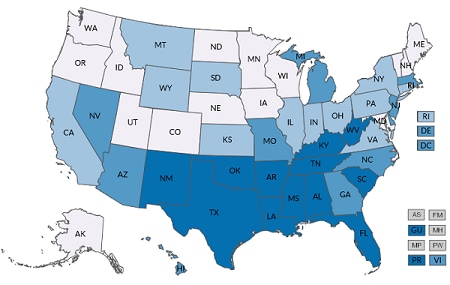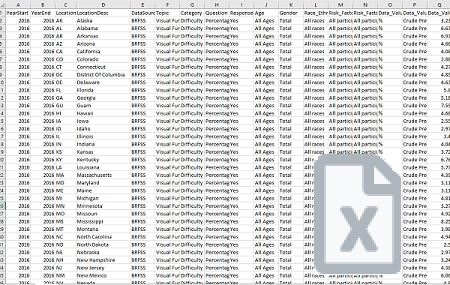Prevalence Estimates – Vision Loss and Blindness
Vision Loss Prevalence Estimates at a Glance
| Data Type | Predicted prevalence rates and prevalence counts created using a statistical modeling approach |
|---|---|
| Source Data |
|
| Case Definition | Best-corrected visual acuity in the better-seeing eye Vision Loss: ≤20/40 Blindness: ≤20/200 |
| Year | Estimates based on 2017 population estimates Released May 2021, revised July 2022 |
| Publications | Prevalence of visual acuity loss or blindness in the US County-Level Variation in the Prevalence of Visual Acuity Loss or Blindness in the US |
| Suggested Citations | Flaxman AD, Wittenborn JS, Robalik T, Gulia R, Gerzoff RB, Lundeen EA, Saaddine J, Rein DB. Prevalence of visual acuity loss or blindness in the US. JAMA Ophthalmology. 2021;139(7):171-23. Lundeen EA, Flaxman AD, Wittenborn JS, et al. County-Level Variation in the Prevalence of Visual Acuity Loss or Blindness in the US. JAMA Ophthalmology. July 7, 2022: doi:10.1001/jamaophthalmol.2022.2405. |
Overview
The VEHSS Composite Prevalence Estimate of Vision Loss is CDC’s primary estimate of vision loss prevalence. VEHSS researchers used a statistical methodology called Bayesian meta-regression to combine information from multiple data sources available in VEHSS to produce vision loss and blindness prevalence estimates among the entire US population in 2017. The estimates are standardized to the national age, gender, and race/ethnicity distribution.
Case Definition:
Vision loss is defined as permanent or uncorrectable vision loss based on the best-corrected visual acuity (BCVA) in the better-seeing eye, as measured using the methodology of the National Health and Nutrition Examination Survey (NHANES). These estimates measure the best visual function obtainable with proper glasses or contact lenses. These estimates do not include vision loss due to inadequate corrective glasses or contacts (uncorrected refractive error). They also do not capture impairment caused only by visual field or contrast sensitivity problems.
- Vision Loss: best corrected visual acuity 20/40 or worse.
- Blindness: best corrected visual acuity 20/200 or worse.
Overall Findings
- In 2017, over 7 million Americans had vision loss or blindness based on best corrected visual acuity in their better-seeing eye (using autorefraction).
- Approximately 6 million Americans have vision loss and 1 million have blindness.
- More than 1.6 million Americans who are living with vision loss or blindness are younger than age 40.
- Over 350,000 people with vision loss or blindness are living in group quarters, such as nursing homes or prisons.
- 20% of all people older than 85 years experience permanent vision loss.
- More females than males experience permanent vision loss or blindness.
- There is a higher risk of vision loss among Hispanic/Latino and Black individuals than among White individuals.
- The prevalence of vision loss varies by state, ranging from 1.3% in Maine to 3.6% in West Virginia.
National Results:
Table 1. Prevalence of Vision Loss and Blindness, Number of People (95% uncertainty interval)
| Vision Loss (Acuity 20/40 or worse) |
Blindness (Acuity 20/200 or worse) |
|
|---|---|---|
| Overall National | 7,053,006 (6,292,752-7,838,472) | 1,097,853 (892,424-1,346,580) |
| Female | 4,141,824 (3,620,443-4,688,726) | 640,278 (501,905-801,266) |
| Male | 2,911,182 (2,538,031-3,334,559) | 457,575 (345,518-574,869) |
| Black (Non-Hispanic) | 1,020,468 (876,655-1,182,522) | 169,540 (131,793-214,820) |
| Hispanic | 1,263,380 (1,074,584-1,485,535) | 127,251 (93,714-162,600) |
| White (Non-Hispanic) | 4,258,742 (3,677,961-4,887,141) | 745,342 (567,133-918,407) |
| Other Race | 510,417 (392,833-617,110) | 55,720 (36,736-76,805) |
| 0-17 Years | 601,972 (392,292-823,895) | 45,520 (24,732-68,623) |
| 18-39 Years | 1,021,796 (841,089-1,168,878) | 101,115 (72,457-134,581) |
| 40-64 Years | 1,258,536 (1,075,196-1,451,485) | 150,003 (110,293-187,494) |
| 65-84 Years | 2,876,846 (2,437,512-3,331,798) | 454,587 (350,588-575,098) |
| 85+ Years | 1,293,856 (1,139,031-1,454,727) | 346,627 (231,117-454,584) |
Figure 1. Prevalence (Percentage of US Resident Population) with Vision Loss or Blindness (Best Corrected Visual Acuity 20/40 Or Worse), by Age Group (in years)
Figure 2. Prevalence (Percentage of US Resident Population) with Vision Loss or Blindness (Best Corrected Visual Acuity 20/40 Or Worse), by Sex and Race
Figure 3. Crude or Adjusted Prevalence (Percentage of US Resident Population) with Vision Loss (Best Corrected Visual Acuity 20/40 Or Worse) or Blindness (Best Corrected Visual Acuity 20/200 Or Worse), by County
*“Crude Prevalence” reports the actual estimated prevalence of vision loss or blindness per county. “Adjusted Prevalence” reports county level estimates standardized to the 2010 US population by age, race/ethnicity, and sex. Adjusted Prevalence shows county-level variation in vision loss or blindness that is not explained by differences in the population distribution by age, race/ethnicity, or sex across counties.
View Detailed Results in VEHSS Data Explorer
Vision Loss (Best Corrected Visual Acuity 20/40 Or Worse)
- State-level and county-level maps or tables and figures showing all states
- National-level figures and tables
- County-level results for a single state
Blindness (Best Corrected Visual Acuity 20/200 Or Worse)
Stage
Stage
- Vision Loss: best corrected visual acuity 20/40 or worse
- Blindness: best corrected visual acuity 20/200 or worse
- Vision Loss: best corrected visual acuity 20/40 or worse
- Blindness: best corrected visual acuity 20/200 or worse
Age Group
Age Group
- All ages
- Detailed age groups (5-year groups)
- Major age groups (0-17, 18-39, 40-64, 65-84, ≥85 years)
- All ages
- Detailed age groups (5-year groups)
- Major age groups (0-17, 18-39, 40-64, 65-84, ≥85 years)
Sex
Sex
- All
- Male
- Female
- All
- Male
- Female
Race/Ethnicity
Race/Ethnicity
- All racial and ethnic groups
- Black (non-Hispanic)
- Hispanic
- White (non-Hispanic)
- Other racial and ethnic groups
- All racial and ethnic groups
- Black (non-Hispanic)
- Hispanic
- White (non-Hispanic)
- Other racial and ethnic groups
Data Type
Data Type
- Crude prevalence
- Adjusted prevalence (adjusted by age, race/ethnicity, and sex)
- Crude prevalence
- Adjusted prevalence (adjusted by age, race/ethnicity, and sex)
Methods
The Vision and Eye Health Surveillance System prevalence estimates of vision loss and blindness were estimated using a statistical modeling approach called Bayesian meta-regression, which researchers used to combine information from multiple VEHSS data sources into a single summary estimate. The VEHSS estimates use measured visual acuity data from the National Health and Nutrition Examination Survey (NHANES) as the reference point dataset to create output based on the characteristics and performance of the NHANES vision exam. In addition to NHANES, the estimation model used population-based study data to provide additional evidence, and self-reported survey data to provide information on variation by state, county and among under-represented population groups.
Full details of the methods are available in the publication and online appendix Flaxman et al 2021.
More Visual Function Indicators in the VEHSS Data Explorer
CDC uses the VEHSS composite estimate as the primary estimate to assess the percentage of people with uncorrectable vision impairment and blindness in the United States by state, county, and across different age groups, race/ethnicity categories, and sex. However, VEHSS also contains several other data sources with prevalence or useful information about vision loss and blindness. Readers should consider all sources when deciding which to use to fit their specific information needs.
Self-Report Measures: VEHSS contains estimates of individuals who reported difficulties with their vision during their survey responses to the American Community Survey (ACS), Behavioral Risk Factor Surveillance System (BRFSS), National Health Interview Survey (NHIS), and the National Survey of Children’s Health (NSCH). These estimates represent people with both correctable and uncorrectable vision problems. Estimates from these sources are sensitive to question wording and the data collection mode (Rein et al. Vision Impairment and Blindness Prevalence in the United States: Variability of Vision Health Responses across Multiple National Surveys). More information comparing different sources of self-report measures is published. The VEHSS vision loss prevalence estimates use two sources of survey self-reported information (ACS and NSCH) to estimate variations in vision loss and blindness geographically (ACS) and among children (NSCH).
Measured Acuity: VEHSS contains national prevalence estimates of measured, correctable and uncorrectable visual acuity deficits from NHANES. The VEHSS vision loss prevalence estimate uses this information and population-based study data to estimate the total number of people with vision loss and blindness in 2017. The original NHANES estimates are available on the VEHSS Data Explorer but are only available at the national level and were last collected in 2008.
The VEHSS Data Explorer also contains information on patients with measured vision impairment or blindness as measured by ophthalmologists and reported to the Intelligent Research in Sight (IRIS) Registry©. The IRIS Registry© data can be used to look at state and population differences but are only applicable to people who visited an ophthalmologist and participated in the IRIS Registry©. Finally, the VEHSS Data Explorer contains a review of selected published vision examination studies. Published results from some of these studies were used to create the VEHSS vision loss prevalence estimate.
Utilization Measures: The VEHSS Data Explorer contains information on using health services related to vision problems as coded in insurance claims information obtained from Medicare, Medicaid, commercial medical insurance (MarketScan), and managed vision care (Vision Service Plan [VSP]) programs, as well as services included in ophthalmology electronic health records summarized by the IRIS Registry©. These estimates measure the proportion of patients who received at least one medical service coded with a diagnosis code for vision impairment or blindness. These measures can be used to assess the proportion of people who received services for diagnosed vision problems.
Summary
Using the VEHSS composite estimates of vision loss is CDC’s best way to estimate the percentage of US residents that have vision loss and blindness and to understand the distribution of vision loss and blindness by demographic and geographic factors. These estimates are based on uncorrectable visual acuity loss, and therefore represent permanent vision loss that cannot be corrected with glasses. These differ from survey self-report estimates, which represent self-assessed visual function, presenting acuity loss included in NHANES, and measures visual acuity based on a person’s current use of glasses or contacts.
Users should consider these differences in measures when deciding if the composite estimates of vision loss, survey self-report, or other data sources are most appropriate to address their research objectives.

